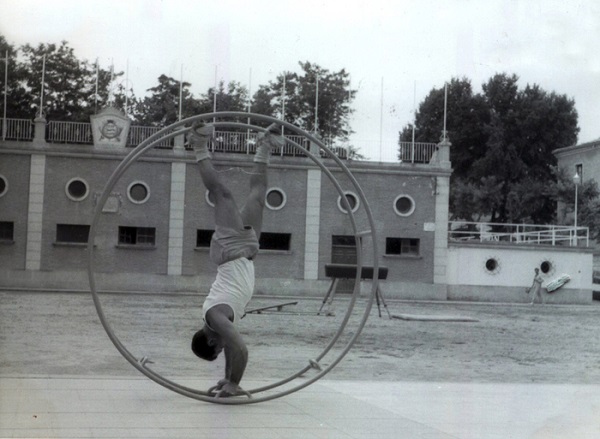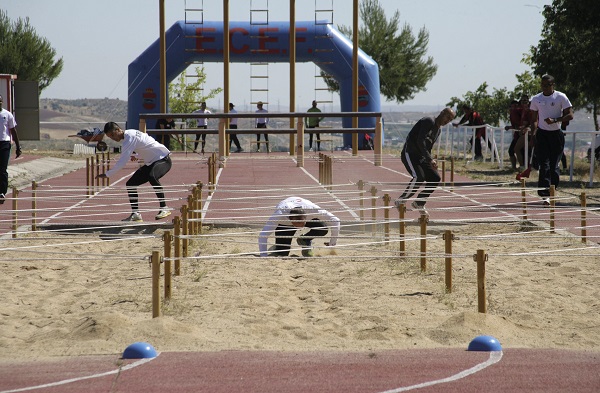- Home
- Feature Articles
- De la Gimnasia a la Educación Física
From Gymnastics to Physical Education
Tuesday, April 2, 2019
Number: 78
ECEF celebrates its first centenary.
Over 8,000 students have passed through the classrooms of the Central School of Physical Education (ECEF) since its creation, in 1919, on the initiative of the Minister of War, General Villalba. Even then, sport and the military were closely linked, as evidenced by the fact that several soldiers represented Spain at the first Olympic Games of the modern era.
Sport was becoming a part of academic training, but not only in the Army. Proof of this is that, in the mid 1920s, the Gymnastic Infant Primer, written and edited by the Central Gymnastics School, was declared a regulation to govern Physical Education in National Primary Schools, and the inspectors and teachers of First Education in Physical Education were trained there. The Primer for the Soldier's Physical Instruction, written according to the Regulation of Physical Instruction for the Army and drafted by the same School, also appeared.
The ECEF, today a top level centre, was born as a Central Gymnastics School in the provisional facilities of the Toledo Shooting Range. Classes were held in the classrooms of the Alcázar de Toledo, and on the grounds of the Shooting Range and the Alijares Camp. In 1927 the construction of sports facilities, which were unique for decades, began on lands close to the historic centre of Toledo; several buildings, tracks and a gymnasium -which was one of the first in Spain- were part of them.
With regard to its name, in October 1939 it changed its name from the Central School of Gymnastics to the Central School of Physical Education, on the grounds that educational gymnastics was only one of the subdivisions of the general concept of Physical Education and, therefore, the new name was more appropriate.

It was in those years when the Company of Experiences was created in the School, the seed of the current Centres of High Sports Performance. Its purpose was for the members of this unit to put into practice training plans, specific feeding programs, etc., and to evaluate the changes in their performance when following them.
During those years, in the 1940s, it became the embryo of the current Military School of Mountain and Special Operations, housing the High Mountain Unit, where skiing and climbing were practised.
Its transfer, in 2001, to the barracks of the Infantry Academy, due to the alienation of the land it occupied by the Toledo City Council, would only mean a change of location, but not of its course. The School -which in some stages has been an independent centre, and at other times has been integrated into the Infantry Academy (as another headquarter) and, at present, depends on the Army’s School of War-, continues to fulfil the tasks for which it was created: Physical Education training for personnel responsible for physical instruction in the Armed Forces, as well as in the State Security Forces and Corps (National Police or Civil Guard). In addition, it is the main advisory body of the Command in matters of Physical Education, within the scope of the Armed Forces. In this sense, it offers courses for Physical Education teachers, instructors and monitors (for officers, non-commissioned officers and troops, respectively), as well as shooting, Close Combat and Non-Lethal Intervention instructor sessions and operational physical preparation.
.

Another of its fundamental tasks is the collaboration in the technical direction of especially complex military sports championships, such as the Military Pentathlon and the Patrol, as well as the Army’s Judo and Fencing, which are usually held in the School.
Attunement with the civil sphere
In these 100 years, the School has managed to earn an outstanding place in the academic field of sport. This is demonstrated by the fact that its personnel participate in conferences and symposia to provide a specialized vision of military sport or specific physical training for the military, and its teachers attend forums and courses of interest to keep up to date.
The ECEF also maintains a fluid relationship with universities such as Castilla-La Mancha, the European University of Madrid and the Polytechnic University of Madrid, to update the teaching staff, share research projects or carry out master's degrees.
This good harmony has earned it several recognitions throughout its history. The most recent, the Gold Medal of the City of Toledo (January 2019), awarded for its contribution to the teaching of sport in the military and civil spheres, as well as its presence in Toledo's social life.
This distinction is added to previous ones such as the Prize of the General Council of Official Schools of Physical Education and Sciences of Physical Activity and Sport of Spain (2010); the Gold Plaque to the Sporting Merit of the Junta de Comunidades de Castilla-La Mancha (1997); or the Gold Plaque to the Sporting Merit of the National Delegation of Physical Education and Sports (1969).
The work of the ECEF requires a constant updating of knowledge, especially in the field of operational physical preparation, necessary to maintain an excellence in teaching. One of its challenges for the future to be able to achieve this is to promote research in order to contribute to this field.
.
ARMY UNITS
- Araba Álava |
- Albacete |
- Alicante |
- Almería |
- Asturias |
- Ávila |
- Badajoz |
- Barcelona |
- Burgos |
- Cáceres |
- Cádiz |
- Cantabria |
- Castellón |
- Ceuta |
- Ciudad Real |
- Córdoba |
- A Coruña |
- Cuenca |
- Girona |
- Granada |
- Guadalajara |
- Gipuzkoa |
- Huelva |
- Huesca |
- Islas Baleares |
- Jaén |
- León |
- Lleida |
- Lugo |
- Madrid |
- Málaga |
- Melilla |
- Murcia |
- Navarra |
- Ourense |
- Palencia |
- Las Palmas |
- Pontevedra |
- La Rioja |
- Salamanca |
- Segovia |
- Sevilla |
- Soria |
- Tarragona |
- Santa Cruz de Tenerife |
- Teruel |
- Toledo |
- Valencia |
- Valladolid |
- Bizkaia |
- Zamora |
- Zaragoza



